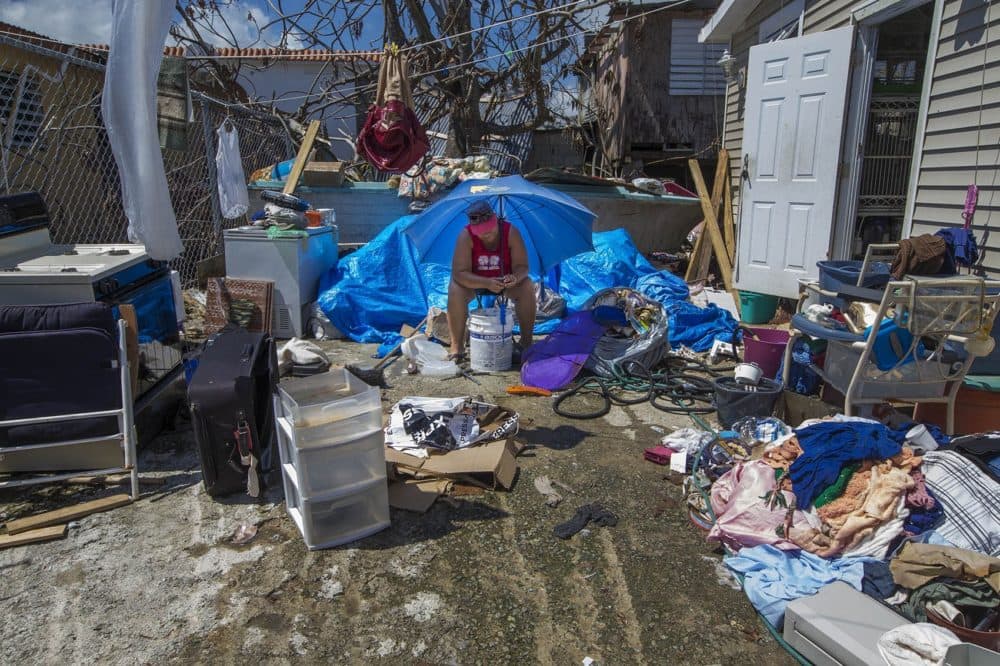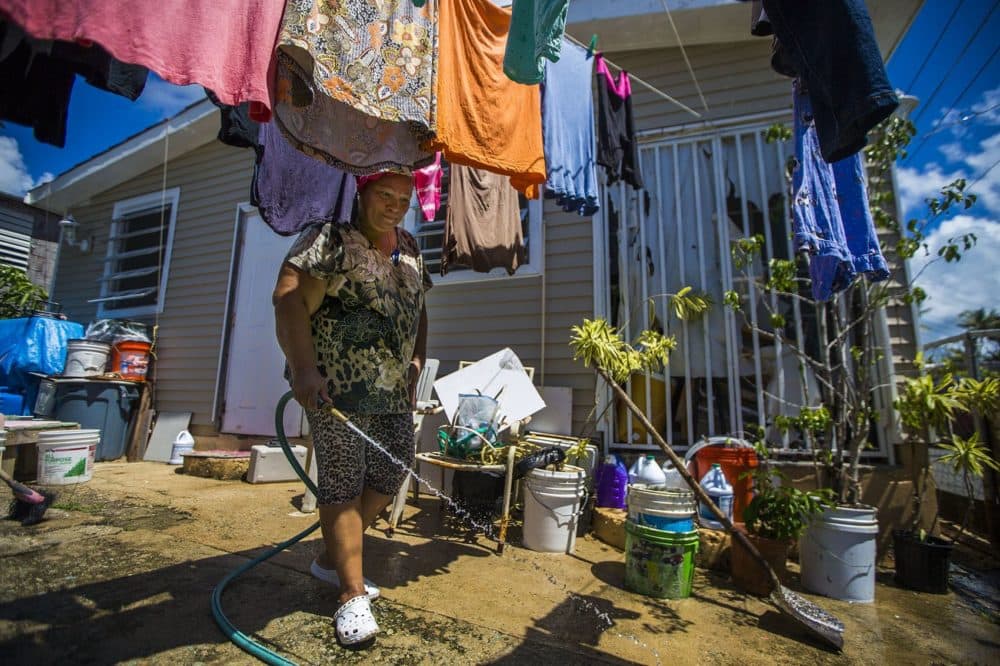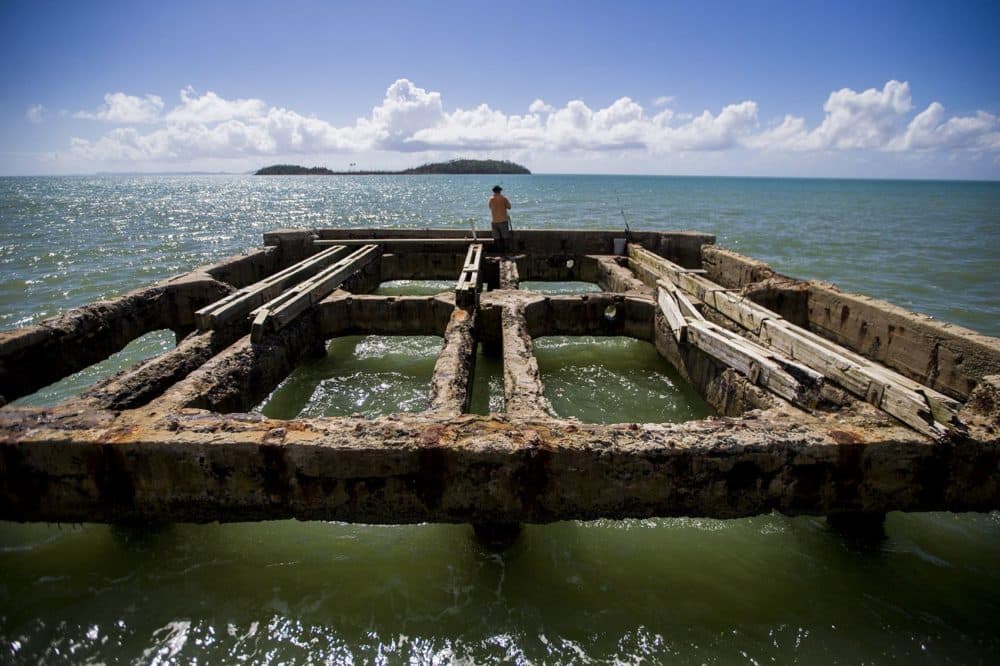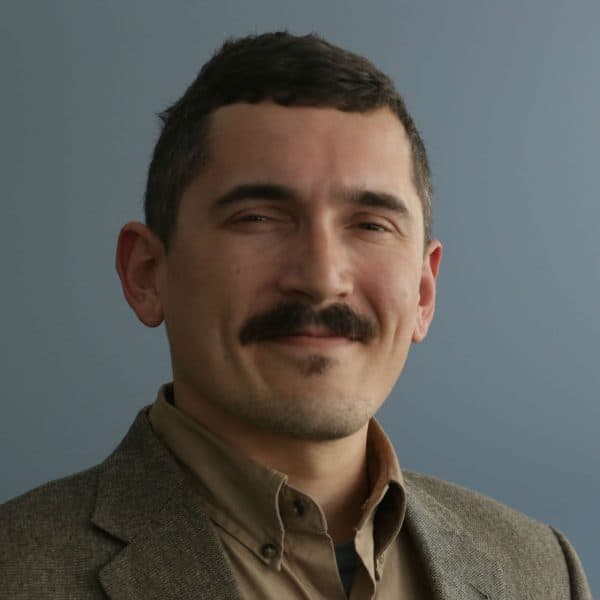Advertisement
Hurricane Maria: 1 Year Later
In Punta Santiago, It's A Microcosm Of A Battered Puerto Rico

A middle-aged woman sat over a pail of water, a blue umbrella shielding her from the scorching sun. Surrounded by a wreckage of branches and twisted metal sheets, Angelina Arroyo Rivera salvaged what remained of her belongings — some silverware and some plastic containers, a blue tarp, a red purse, a white blouse.
It was two weeks after Hurricane Maria had made landfall, not far from the town of Punta Santiago in the southeast of Puerto Rico, and Arroyo still hadn’t heard from her partner, who was in grave condition with a failing heart. She said he’d been transferred to a hospital in another city, the day before the storm, and with communications down across the island, she hadn't heard from him in weeks.
A year later at the same spot — with the image of her under the blue umbrella ingrained in our minds — we found Arroyo cleaning her patio with a hose.
I asked her in Spanish how she was doing.
“Regular las cosas,” she replied, which I translate roughly to “so-so."
And her husband?
“He passed away,” she said. “He had two heart attacks. The first he survived, the second he did not.”

At 55 years old, José Miguel Martínez Morales joined some 3,000 islanders who would die in the wake of the storm — because of the storm, by Arroyo’s account.
“He raised three of my kids and I raised one of his,” she said. “As a person, he was the best.”
Arroyo's neighborhood was hit particularly hard by the hurricane. Maybe 100 yards away from her house, there’s a canal with stagnant water, and when the floodwaters came in they swept away entire homes. Some of them remain abandoned, a stubborn reminder of the worst hurricane in living memory. Arroyo’s home stayed mostly intact, but the floodwaters rose more than 6 feet high, and everything she had was soaked in the salty, brackish water.
A year later, she said the drywall in her house is still damp.
“Nobody came to help me fix the house,” she said. “So I went back into my house, with the black water still inside, and I just continued living there."
Arroyo said she received $10,000 from FEMA, which would make her fortunate compared to neighbors who she said got nothing. But she said with the cost of construction and materials skyrocketing after the storm, she hasn’t been able to do much work on the house.
“Nobody came to help me fix the house. So I went back into my house, with the black water still inside, and I just continued living there."
Angelina Arroyo Rivera
With family in Connecticut, Arroyo had a way out. But she wanted to stay in Puerto Rico.
"My daughter said, ‘Mami, come stay with me,’ and I said, ‘I’m not leaving, I’m not leaving, I’m not leaving.’
“I can’t adapt to life over there [on the mainland],” she said. "I like freedom, to be free like a bird. I can’t stand being holed up inside all the time like people do in the States. I’m happy here cleaning — with my plants.”
Arroyo embodies three things that so many Puerto Ricans faced over the last year — death, destruction and the heart-wrenching decision of whether to abandon the island for the mainland. And like many people struggling with the stunted return to normality, Arroyo attributes her survival to the divine.
“It’s hard, but as long as you have ‘Papito Dios’ in your heart and your soul, you’ll be standing tall," she said. "That’s what gives me, the strength to stay alive."
Arroyo said she was prepared to take care of her husband once he was released from the hospital.
“His family wanted to bring him to a nursing home, but not me. Even if he became a vegetable, I was going to take care of him. But God didn’t want it that way.”
The Dock

A stone’s throw from Arroyo’s home is the town dock of Punta Santiago. A year earlier, Pedro Morales Oquendo, a nonprofit leader in the community, made a point of showing us how the dock’s planks had been lifted up by the floodwaters and strewn across the town. The dock was central to Punta Santiago’s beach culture, and the local fishermen used it to head out to sea.
A year later, we wanted to see if it had been fixed.
No, the dock was still in shambles.
“The reconstruction effort in Puerto Rico has been slow,” Morales said, standing on the few planks that remained intact. "The agencies responsible for the reparation of the whole island have moved extremely slowly, compared to other events that have occurred in Puerto Rico, like Hurricane George and Hurricane Hugo."
And he should know. Morales served in the National Guard and was part of the response to Hugo, which hit Puerto Rico in 1989.
“There’s a tremendous difference [in how the government reacted],” he said.
Morales is vice president of the nonprofit PECES, which deals with everything from education to economic development. In Maria's aftermath, like many nonprofits across the island, PECES became a de facto relief organization, receiving donations from initiatives like Massachusetts United for Puerto Rico, which has raised $3.8 million for groups helping Puerto Ricans on the island and in Massachusetts.
A year later, Morales said PECES is back to its original mission, though helping the town recover from the hurricane has become part of that mission.
“I would say 100 percent of the houses in Punta Santiago were damaged in the storm,” he said.
But not everyone who believed they were entitled to federal relief dollars actually received any — including Morales himself. He raised an issue that’s become one of the most controversial aspects of the government’s response to the Puerto Rican disaster: FEMA's rejection of applications for individual relief.
The problem, he said, traces back to land ownership.
"The most important criteria to FEMA was whether people had titles, not the damage they suffered," he said. "To qualify you have to prove that you are an owner.”
It sounds like a reasonable requirement — and FEMA notes that it's the law — but Morales said it’s an impractical demand for owners of land passed down through generations.
"Because they lived their whole life there,” he said. “They lived there since their grandparents owned the land … but they did not have the documentation to being owners. And they were immediately rejected [by FEMA].”
The problem spreads across the island of Puerto Rico. In an August letter to FEMA signed by both Massachusetts senators, a group of Senate Democrats said FEMA had rejected 61 percent of the more than 1 million applications for relief. More than 43,000 appeals to those rejections came in, according to figures cited in the senators' letter, and FEMA denied 79 percent of the appeals.
Facing criticism over the home ownership verification process, FEMA defended its work in March, saying in a statement that it was "exhausting all options ... to help Puerto Rico disaster survivors for whom proof of ownership is slowing their recovery."
According to a FEMA spokesperson on Thursday, its appeal denial rate in Puerto Rico is nearly 75 percent, which is “in line with appeal denial rates of other current open disasters,” including Texas 77 percent and Florida 74 percent.
However, FEMA did not provide the initial denial rates for the three jurisdictions, citing the “complex nature of home ownership in Puerto Rico."
Morales was one of those who appealed without success.
“FEMA has been in the community. We can’t deny that,” he said. “But the appeals process can take months and people don’t have time to wait. This is humanity we’re talking about, people who want to return to their houses, people [who] want to work.” And in many cases, he added, “we’re talking about children."
He said this is part of why so many people left Punta Santiago — an “exodus to the United States” that he had warned of a year earlier. Asked for an estimate of how many have moved, Morales pointed to his wife, a kindergarten teacher. Before the storm she had 27 students; about 10 have now left the country with their families.
“We can’t just tell people, ‘Hey, don’t leave.’ This was a truly grave situation, and everybody needs to look out for their family’s well being," he said. "If we were in their shoes we would probably do the same.”
Morales laments Punta Santiago's problems — the decrepit infrastructure, the economic challenges, the slow recovery — but he sees a way for things to turn around.
His call to the federal government is this: “There should be investment in mitigation, so people can install flood-proof doors and windows. ... If FEMA is proactive, then when the next hurricane comes, the people will be ready. And after the next hurricane, people will say, ‘Thank you to FEMA for allowing me to make my house resilient.' ”
Until then, groups like PECES have to fill the gap, and turn to others on the island to help make it possible. That’s what happened with the dock. Through the organization Unidos Por Puerto Rico, PECES secured $1.8 million to rebuild the dock, and to fix the houses of 100 families in Punta Santiago.
This article was originally published on October 04, 2018.
